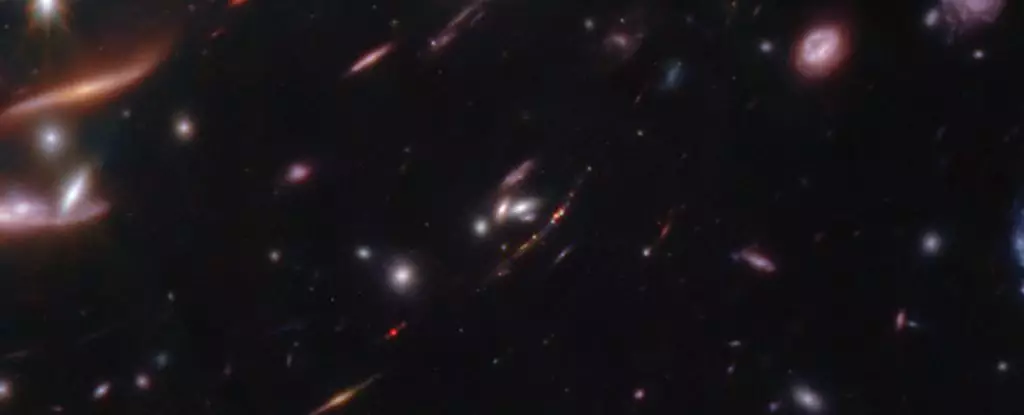Deep within the cosmos, a striking revelation unfolds, offering insight into the formative years of our Universe. Named Firefly Sparkle, this galaxy exists 600 million years post-Big Bang and is shedding light on the early stages of galactic formation, including the potential characteristics of our own Milky Way in its infancy. As we gaze through the lens of history, what we see is a vibrant tapestry of star creation, a true spectacle made possible by the advances in astrophysical technology and the mysterious mechanics of gravity.
To comprehend the extraordinary views of Firefly Sparkle, it’s crucial to understand the phenomenon of gravitational lensing. When massive objects, such as galaxy clusters, occupy the foreground in our line of sight, their gravitational fields bend the light from distant sources, enhancing our observational capabilities. This bending of space-time creates a “magnifying glass” effect, allowing light from remote galaxies to reach Earth in a distorted yet illuminating form. Astronomers harness this phenomenon to transform what would otherwise appear as mere smudges of light into intricate and coherent images of distant celestial bodies.
In the case of Firefly Sparkle, light traveled across 13.2 billion years to traverse the vast cosmic expanse. The galaxy’s shimmering light emerges from behind a powerful galaxy cluster whose own light has taken 5.3 billion years to arrive. The James Webb Space Telescope (JWST), with its unparalleled infrared capabilities, skillfully captures the red-shifted light that allows scientists to delve deeper into the structure and dynamics of the cosmos during its infancy.
The findings concerning Firefly Sparkle are astonishing. Within this galaxy, astronomers have identified ten distinct clusters of stars, each contributing to the overall mass and complexity of this young galaxy. “The sheer quantity and variety of star formation we are observing are remarkable,” states astrophysicist Lamiya Mowla of Wellesley College. “To resolve so many components in a galaxy from such an early time period was beyond my expectations.”
The galaxy’s profile reveals a teardrop shape, aglow with energetic star formation phases. Among its features is a mixture of colors representing different stellar ages, indicating that star creation is not a synchronous process. Instead, each cluster contributes uniquely to the great tapestry of galactic development, painting a vivid picture of celestial evolution.
The Cosmic Dawn, spanning the first billion years since the Big Bang, is a cornerstone era that has captured the interest of cosmologists and astronomers alike. In this primordial epoch, matter underwent significant transformations, coalescing from a fog of particles into identifiable galaxies and stars. Understanding these transformations helps frame our concepts of cosmic history and the fundamental processes of evolution in space.
Firefly Sparkle offers a unique glimpse into this epoch. Through the detection of various star clusters and their differing stages of life, researchers witness the ongoing assembly of a galaxy—an act that foretells the eventual formation of more extensive structures such as the Milky Way. Furthermore, the observation of close neighbor galaxies hints at the dynamic interactions typical in the early Universe, where smaller galaxies merge, collectivize, and grow into more prominent cosmic entities.
The implications of these observations extend beyond the borders of Firefly Sparkle. By studying this nascent galaxy, we glean insights about the origins of our own Milky Way—a galaxy shaped by alliances and cannibalism of its smaller counterparts. Astrophysicist Yoshihisa Asada proposes that realizing merging dynamics is crucial to understanding how galactic growth unfolds. The potential for discovering more such galaxies enhances our ability to piece together the narrative of galactic evolution.
Moreover, the advances brought forth by the JWST signal a new phase of discovery, facilitating the examination of multiple galaxies currently hidden within the Cosmic Dawn. “This is only the beginning,” notes astronomer Maruša Bradač from the University of Ljubljana. “Like how microscopes unveiled previously unseen details in biology, JWST is set to unlock more secrets of cosmic architecture.”
Firefly Sparkle has emerged as a beacon of knowledge, illuminating our understanding of galactic formation processes. The intricate details unveiled by gravitational lensing and the and advanced capabilities of the JWST will vastly enrich our comprehension of the Universe in its formative years. Each revelation not only addresses fundamental questions about our cosmic origins but also enhances our understanding of the intricate networks that foster stellar and galactic development. As we journey deeper into the cosmos, each new discovery unfolds the intricate dance of dark and light, time and matter, essential to our existence in the universe.


Leave a Reply